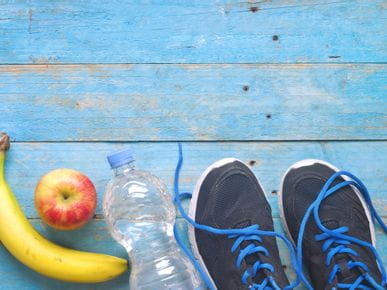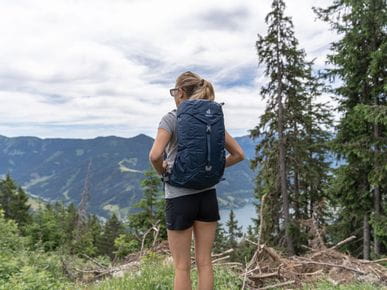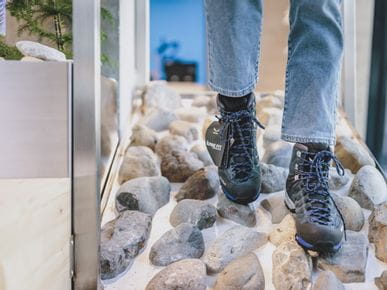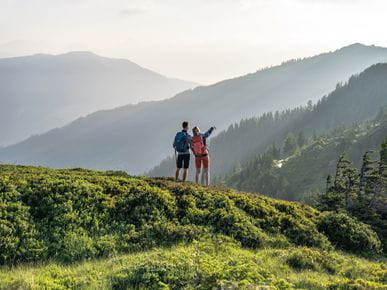Every break deservs a bite to eat
Hiking is good for the soul, as we all know. But it can also be quite a treat for the palate as well. The fresh mountain air and views of the surrounding mountain peaks stretching out before you turn even the simplest snack into a veritable feast. After all, what could be more beautiful after, or during an extended hike, than munching atop the peak you have just conquered? That’s right – essentially nothing! So, what provides you with the best nutrition and gives you the biggest energy boost? Our recipes are guaranteed to answer all of your questions and your body is certain to thank you for it.
After a lengthy tour, your energy reserves are almost empty and need to be topped up urgently. At that point, what you need is balanced nutrition consisting of carbohydrates, fats and proteins. Bacon, cheese and bread are hikers’ classics in this part of the world, of course, though we have to point out, a slight change of pace might be even better for your body.
thomas-marzusch.jpg)
Carbohydrates
Carbohydrates are the primary energy source since they metabolize into sugar and enter the blood supply the most rapidly. If you gasp in horror when you read the word “sugar”, not to worry, since several of your organs are fed exclusively by sugars (including your brain cells). However, if your energy reserves are severely depleted, you will develop a low blood sugar sensation. Dizziness, trembling and nausea are some of the most common symptoms. Because of that, people urgently need complex carbohydrates such as fruit or whole-grain products. Simple sugars, such as found in a chocolate bar, do give you a quick energy jolt, though the effects are not sustained and, in the long term, actually weaken the body even more.
Also extremely important are proteins, which are found in dairy products, fish, meat and oatmeal especially. They will provide you with the strength you need for your hike and your muscles will ultimately reap the benefits.
Last but not least, you need fats, which are contained in nuts, dairy products, avocados etc. However, too many fats prevent the absorption of carbohydrates and proteins, so you should always strive to find the right balance. A rough rule of thumb is 50 – 60 % carbs, 25 – 30 % fat and 10 – 15 % protein.
The right eating plan
Preparation for your hike should begin one day, or at the latest the morning before your tour. You are recommended not to eat meals that are hard to digest. The emphasis should be on foods that are high in fiber such as oatmeal, whole-grain bread and fresh fruit. In the morning, you shouldn’t forget to drink either since your body will be sweating constantly and losing a significant amount of water as a consequence.
During the tour itself, we recommend the same combination of carbohydrates, proteins and fats as described above. To that end, we suggest our so-called Energy Balls as well as high-protein bread topped with cheese and vegetables. In between, we suggest smaller snacks, which will be less challenging on your digestive system and provide your body with the constant energy flow it needs for the hike.
Afterwards, you should make sure you get something to eat within two hours of completing your tour, which will allow for optimal regeneration. You will also need to compensate for fluid loss, though more about that below.
thomas-marzusch.jpg)
Drinking regularly
Having enough to eat, but also getting adequate fluids is something you shouldn’t forget. If you begin to feel thirsty, this is the first indication of dehydration. That’s why “regularly” is the key word, as it will prevent any potential deficiency in vital minerals. Your best options are water or an isotonic beverage.
Isotonic Drink
Everybody can make their own natural isotonic sports beverage. It’s not hard to do and it will help you maintain the correct mineral balance in your body. You also won’t have to spend much money on it, since you will probably already have most of the ingredients you need in your own home. Sports drinks you find in stores are generally way too expensive and contain unnecessary additives such as artificial aromas. All you need is:
- 1/2 l organic apple juice,
- 1/2 l mineral water,
- 1 g salt,
- 2 tbsp dextrose
Simply mix the apple juice with the salt and dextrose, then top up with water or mineral water (for added freshness). Pour it into a bottle and your homemade isotonic drink is ready to go.
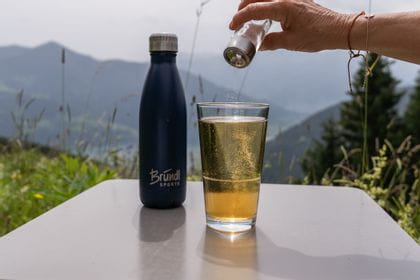
Recipe for Energy Balls
These small balls are fantastic alternatives to chocolate bars etc. since they taste naturally sweet without the need for added sugar, they provide energy and they contain lots of nutrients. Look at this short list of ingredients, then head for the kitchen.
- 1 cup of dates
- 1 tsp cinnamon
- 3 tbsp seeds (chia, hemp or flax seeds)
- 1 pinch of salt
- ½ cup of oatmeal
- ½ cup of nuts – for example walnuts, hazelnuts, sunflower seeds, almonds
- 4-5 tbsp nut spread (such as almond, cashew, peanut)
Chop all ingredients down to the desired consistency (using a kitchen blender, knife or hand blender) and mix together. Then, form the mix into small balls and roll through cocoa powder, shredded coconut, acai powder etc. as you please. These balls keep in the refrigerator for up to 1 ½ weeks.
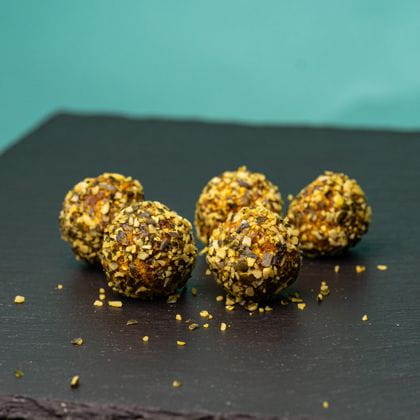
High-Protein Bread
This bread does not contain white flour, sugar or other nutritional supplements. However, it is full of proteins, iron, vitamins and simultaneously gluten-free. Per slice, this super bread contains around 100 cal. The baking time in a regular oven at 180°C/355°F is roughly 60 minutes and you don’t have to allow the dough to rest. All you need to put on your shopping list is:
- 500g lowfat quark
- 250g oat bran (gluten-free)
- 5 eggs
- 1 package of baking powder
- 2 tsp salt
- 40g walnuts, sunflower seeds etc.
- 1 pinch of turmeric
- 1 carrot
Preheat the oven to 180°C/355°F. Line a loaf-shaped baking dish (25 cm in length) with baking paper or use a silicon baking dish.
Chop up the walnuts coarsely, grate the carrots coarsely, mix and stir together all ingredients.
Fill the baking dish with the dough and bake for 60 minutes. If you wish, you can sprinkle sunflower seeds, nuts etc. in or on top of the bread. Finally, don’t forget to add a big helping of love. Et voilà!
With this nutritious snack stowed away in your pack, nothing more stands in the way of your hike and you will be able to enjoy all of your treats with a clear conscience. So, head for the kitchen, then pull on your hiking boots! Have lots of fun and above all: Bon appetit!
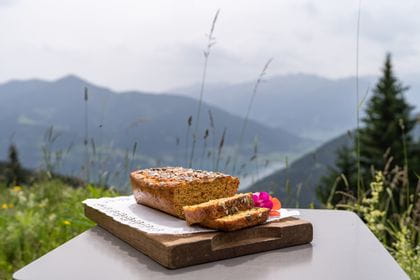
Your packing list for a powerful body and mind:
- at least 1 to 2 liters of water and/or an isotonic drink
- fresh fruit
- vegetables (e.g. carrots, cucumbers)
- high-protein bread
- Energy Balls
- tea (in winter)
thomas-marzusch.jpg)
